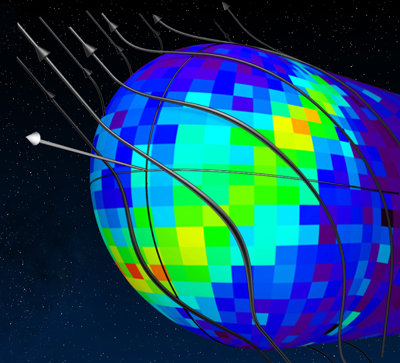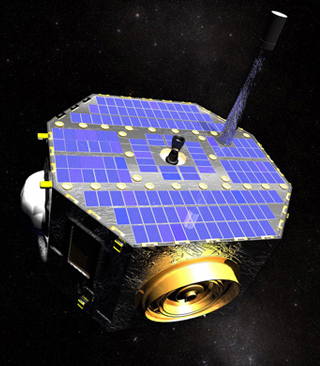IBEX Mission Changes its SOCs
UNH gains a bigger role in NASA’s effort to map the “space between the stars”
WHEN ASSOCIATE PROFESSOR Nathan Schwadron left Boston University to join the Space Science Center and the physics department, he beefed up UNH’s already substantial involvement in the Interstellar Boundary Explorer mission. Schwadron is lead scientist for the IBEX Science Operations Center, or ISOC, and, thus, as he goes so goes the center.
And since the IBEX satellite is currently hard at work making the first maps of the edge of our solar system, seamlessly moving the center from Boston to Durham without bollixing up the data was mission critical.
“We took a staged, leap-frog process that involved creating a ‘shadow science operations center’ then moving backup computers to UNH to eventually become the primary ISOC machines,” Schwadron explains. “When we were convinced all was well we flipped the switch and kept backups running at BU in case anything failed.”
Nothing did. So Schwadron rented a 26-foot U-Haul truck, stuffed it with remaining ISOC gear, and headed north. Now, every week, after the 28-inch-tall by 38-inch-wide spacecraft completes one of its huge elliptical Earth orbits, IBEX transmits its data to the Mission Operations Center at Orbital Sciences Corporation in Dulles, Virginia and, three hours later, ISOC grabs the data and stores it on half a dozen server-class Linux boxes in Morse Hall’s Research Computing Center. UNH mission team members then begin their initial analysis of the now in-house data set.
What IBEX’s data has revealed thus far has exceeded expectations in terms of discovery and has brought no shortage of surprises and new questions. In late September, after a year and a half of active measurements in space, the IBEX science team published the second set of global images of the heliosphere – the huge, magnetic bubble that surrounds the Sun and marks the boundary of our solar system with interstellar space. The maps show surprisingly rapid changes in this vast region that is the solar system’s, and thus Earth’s, first protective barrier from harmful galactic cosmic rays.
Says Schwadron, “These measurements from IBEX are stunning observations of the global interaction and we’re just beginning to learn how the heliosphere works as a whole. That’s an incredible new paradigm.”
The first set of images from IBEX, revealed in October of 2009, showed an entirely unexpected feature: a bright ribbon that “paints across the heliosphere,” explains Schwadron adding, “this was completely unpredicted by any model or theory prior to IBEX and has people really scratching their heads.”
Complicating matters is the appearance of a bright knot of intense emission from the ribbon, which, in the new maps, appears to be spreading out.
Schwadron uses the analogy of a room filled with bungee cords hanging from the ceiling and a beach ball being dragged through it. The bungee cords are the interstellar magnetic field lines and the beach ball is the heliosphere, which as it is dragged through the room (the interstellar medium) gets squeezed, and this is what creates the bright ribbon of particle emissions. So one theory goes; there are currently more than half a dozen different theories vying to explain the origin of the mysterious ribbon and the apparent “untying of the knot,” but, Schwadron elaborates, “none of the ideas so far proposed can fully account for the surprising new observations from IBEX."
A mission strengthened
SSC scientists, engineers, and students have been intimately involved in the IBEX mission from its very beginnings. The SSC team, led by principal investigator Eberhard Möbius, constructed critical components for the two ultra-high sensitivity cameras onboard the spacecraft – IBEX-Hi and IBEX-Lo. The cameras capture incoming atoms (rather than light waves) to produce images of heliospheric boundaries. SSC scientists and engineers are most concerned with the IBEX-Lo sensor, which measures the low-energy heliospheric neutral atom spectrum; IBEX-Hi measures the higher energy neutral atoms.
Having the ISOC in-house greatly strengthens UNH’s role in the mission. The ISOC is responsible for leading the on-orbit science operations of the spacecraft as well as generating the maps from the raw telemetry sent down from space.
One of the first team members to look at the new data each week is research associate professor Harald Kucharek, who says being able to have face-to-face communications with Schwadron and others affiliated with the ISOC ultimately facilitates the science. (Kucharek, who was involved in building and commissioning the IBEX-Lo instrument, is also working on one of the aforementioned theories hoping to explain the mysterious ribbon.)
Says Kucharek, “It just makes things easier and more efficient having people who designed and built the sensor, the software people, and the science operations people together to routinely check the health of the spacecraft and test efficiencies of a particular item.” For example, Kucharek explains, to make sure IBEX-Lo is doing what it’s supposed to do, engineers (including SSC’s David Heirtzler) will periodically upload little software programs and let them run to make sure all’s well. “If there is a sign of degradation of the count rate, things like that, we can immediately run some diagnostics and make any necessary adjustments.”
Both Schwadron and Kucharek note that the bigger picture of the IBEX mission is gaining a fundamental understanding of “astropheres” throughout the universe. Like our own heliosphere’s role in tempering the amount of cosmic rays that reach our planet (and plenty still do and are thought to have played a vital role in the evolution of life on Earth), astropheres could be a key piece to answering the question; Are we alone?
“It’s probably the case that an astrosphere, similar to our heliosphere, is around every single star,” Schwadron says, “ and that makes you wonder whether life exists in these other systems. Understanding the types of interactions that shield galactic cosmic radiation around other stars and other habitable environments is key to understanding what makes those environments habitable at all. Is there too much radiation, is there enough to spur on evolution? So those are some of the cosmic questions that relate to what we’re looking at locally.”
IBEX is one of NASA’s Small Explorer Program missions, which by design are more highly focused and less expensive than bigger satellite missions shot into space from a ground-based rocket. At launch, the spacecraft was first secured inside a winged Pegasus rocket, cinched to the belly of an Air Force L-1011 widebody jet, and then let fly in skies over the Kwajalein Atoll in the South Pacific before thundering into outer space. The mission’s principal investigator is David McComas of the Southwest Research Institute (SwRI) in San Antonio, Texas.
And since the IBEX satellite is currently hard at work making the first maps of the edge of our solar system, seamlessly moving the center from Boston to Durham without bollixing up the data was mission critical.
“We took a staged, leap-frog process that involved creating a ‘shadow science operations center’ then moving backup computers to UNH to eventually become the primary ISOC machines,” Schwadron explains. “When we were convinced all was well we flipped the switch and kept backups running at BU in case anything failed.”
 |
|
| Nathan Schwadron Photo by K.Donahue, UNH-EOS. |
What IBEX’s data has revealed thus far has exceeded expectations in terms of discovery and has brought no shortage of surprises and new questions. In late September, after a year and a half of active measurements in space, the IBEX science team published the second set of global images of the heliosphere – the huge, magnetic bubble that surrounds the Sun and marks the boundary of our solar system with interstellar space. The maps show surprisingly rapid changes in this vast region that is the solar system’s, and thus Earth’s, first protective barrier from harmful galactic cosmic rays.
Says Schwadron, “These measurements from IBEX are stunning observations of the global interaction and we’re just beginning to learn how the heliosphere works as a whole. That’s an incredible new paradigm.”
The first set of images from IBEX, revealed in October of 2009, showed an entirely unexpected feature: a bright ribbon that “paints across the heliosphere,” explains Schwadron adding, “this was completely unpredicted by any model or theory prior to IBEX and has people really scratching their heads.”
Complicating matters is the appearance of a bright knot of intense emission from the ribbon, which, in the new maps, appears to be spreading out.
Schwadron uses the analogy of a room filled with bungee cords hanging from the ceiling and a beach ball being dragged through it. The bungee cords are the interstellar magnetic field lines and the beach ball is the heliosphere, which as it is dragged through the room (the interstellar medium) gets squeezed, and this is what creates the bright ribbon of particle emissions. So one theory goes; there are currently more than half a dozen different theories vying to explain the origin of the mysterious ribbon and the apparent “untying of the knot,” but, Schwadron elaborates, “none of the ideas so far proposed can fully account for the surprising new observations from IBEX."
A mission strengthened
SSC scientists, engineers, and students have been intimately involved in the IBEX mission from its very beginnings. The SSC team, led by principal investigator Eberhard Möbius, constructed critical components for the two ultra-high sensitivity cameras onboard the spacecraft – IBEX-Hi and IBEX-Lo. The cameras capture incoming atoms (rather than light waves) to produce images of heliospheric boundaries. SSC scientists and engineers are most concerned with the IBEX-Lo sensor, which measures the low-energy heliospheric neutral atom spectrum; IBEX-Hi measures the higher energy neutral atoms.
Having the ISOC in-house greatly strengthens UNH’s role in the mission. The ISOC is responsible for leading the on-orbit science operations of the spacecraft as well as generating the maps from the raw telemetry sent down from space.
One of the first team members to look at the new data each week is research associate professor Harald Kucharek, who says being able to have face-to-face communications with Schwadron and others affiliated with the ISOC ultimately facilitates the science. (Kucharek, who was involved in building and commissioning the IBEX-Lo instrument, is also working on one of the aforementioned theories hoping to explain the mysterious ribbon.)
Says Kucharek, “It just makes things easier and more efficient having people who designed and built the sensor, the software people, and the science operations people together to routinely check the health of the spacecraft and test efficiencies of a particular item.” For example, Kucharek explains, to make sure IBEX-Lo is doing what it’s supposed to do, engineers (including SSC’s David Heirtzler) will periodically upload little software programs and let them run to make sure all’s well. “If there is a sign of degradation of the count rate, things like that, we can immediately run some diagnostics and make any necessary adjustments.”
Both Schwadron and Kucharek note that the bigger picture of the IBEX mission is gaining a fundamental understanding of “astropheres” throughout the universe. Like our own heliosphere’s role in tempering the amount of cosmic rays that reach our planet (and plenty still do and are thought to have played a vital role in the evolution of life on Earth), astropheres could be a key piece to answering the question; Are we alone?
“It’s probably the case that an astrosphere, similar to our heliosphere, is around every single star,” Schwadron says, “ and that makes you wonder whether life exists in these other systems. Understanding the types of interactions that shield galactic cosmic radiation around other stars and other habitable environments is key to understanding what makes those environments habitable at all. Is there too much radiation, is there enough to spur on evolution? So those are some of the cosmic questions that relate to what we’re looking at locally.”
IBEX is one of NASA’s Small Explorer Program missions, which by design are more highly focused and less expensive than bigger satellite missions shot into space from a ground-based rocket. At launch, the spacecraft was first secured inside a winged Pegasus rocket, cinched to the belly of an Air Force L-1011 widebody jet, and then let fly in skies over the Kwajalein Atoll in the South Pacific before thundering into outer space. The mission’s principal investigator is David McComas of the Southwest Research Institute (SwRI) in San Antonio, Texas.
by David Sims, Science Writer, Institute for the Study of Earth, Oceans, and Space. Published in Fall 2010 issue of EOS .


